-

新人教版高中英语选修2Unit 4 Using langauge-Listening教学设计
The theme of the listening section is " talking about scenery and culture along a journey."The part is designed to further lead the students to understand Canadian natural geography and social environment, and integrated into the cultural contrast by mentioning the long train journey from Beijing to Moscow routes. On this basis, the part activates students related travel experience, lets the student serial dialogue, guides the student to explore further the pleasure and meaning of the long journey, and Chinese and foreign cultural comparison.The part also provides a framework for the continuation of the dialogue, which is designed to provide a framework for students to successfully complete their oral expressions, and to incorporate an important trading strategy to end the dialogue naturally.1. Help students to understand and master some common English idioms in the context, and experience the expression effect of English idioms.2. Guide the students to understand the identity of different people in the listening context, and finish the dialogue according to their own experience.3. Instruct the students to use appropriate language to express surprise and curiosity about space and place in the dialogue, and master the oral strategy of ending the dialogue naturally.1. Instruct students to grasp the key information and important details of the dialogue.2. Instruct students to conduct a similar talk on the relevant topic.

新人教版高中英语选修2Unit 5 Learning about Language教学设计
The purpose of this section of vocabulary exercises is to consolidate the key words in the first part of the reading text, let the students write the words according to the English definition, and focus on the detection of the meaning and spelling of the new words. The teaching design includes use English definition to explain words, which is conducive to improving students' interest in vocabulary learning, cultivating their sense of English language and thinking in English, and making students willing to use this method to better grasp the meaning of words, expand their vocabulary, and improve their ability of vocabulary application. Besides, the design offers more context including sentences and short passage for students to practice words flexibly.1. Guide students to understand and consolidate the meaning and usage of the vocabulary in the context, 2. Guide the students to use the unit topic vocabulary in a richer context3. Let the students sort out and accumulate the accumulated vocabulary, establishes the semantic connection between the vocabulary,4. Enable students to understand and master the vocabulary more effectivelyGuiding the Ss to use unit topic words and the sentence patterns in a richer context.Step1: Read the passage about chemical burns and fill in the blanks with the correct forms of the words in the box.

新人教版高中英语选修2Unit 5 Reading and thinking教学设计
The theme of this activity is to learn the first aid knowledge of burns. Burns is common in life, but there are some misunderstandings in manual treatment. This activity provides students with correct first aid methods, so as not to take them for granted in an emergency. This section guides students to analyze the causes of scald and help students avoid such things. From the perspective of text structure and collaborative features, the text is expository. Expository, with explanation as the main way of expression, transmits knowledge and information to readers by analyzing concepts and elaborating examples. This text arranges the information in logical order, clearly presents three parts of the content through the subtitle, accurately describes the causes, types, characteristics and first aid measures of burns, and some paragraphs use topic sentences to summarize the main idea, and the level is very clear.1. Guide students to understand the causes, types, characteristics and first aid methods of burns, through reading2. Enhance students’ ability to deal withburnss and their awareness of burns prevention3. Enable students to improve the ability to judge the types of texts accurately and to master the characteristics and writing techniques of expository texts.Guide students to understand the causes, types, characteristics and first aid methods of burns, through readingStep1: Lead in by discussing the related topic:1. What first-aid techniques do you know of ?CPR; mouth to mouth artificial respiration; the Heimlich Manoeuvre

新人教版高中英语选修2Unit 5 Using langauge-Listening教学设计
The theme of this section is to learn how to make emergency calls. Students should learn how to make emergency calls not only in China, but also in foreign countries in English, so that they can be prepared for future situations outside the home.The emergency telephone number is a vital hotline, which should be the most clear, rapid and effective communication with the acute operator.This section helps students to understand the emergency calls in some countries and the precautions for making emergency calls. Through the study of this section, students can accumulate common expressions and sentence patterns in this context. 1.Help students accumulate emergency telephone numbers in different countries and learn more about first aid2.Guide the students to understand the contents and instructions of the telephone, grasp the characteristics of the emergency telephone and the requirements of the emergency telephone.3.Guide students to understand the first aid instructions of the operators.4.Enable Ss to make simulated emergency calls with their partners in the language they have learned1. Instruct students to grasp the key information and important details of the dialogue.2. Instruct students to conduct a similar talk on the relevant topic.Step1:Look and discuss:Match the pictures below to the medical emergencies, and then discuss the questions in groups.
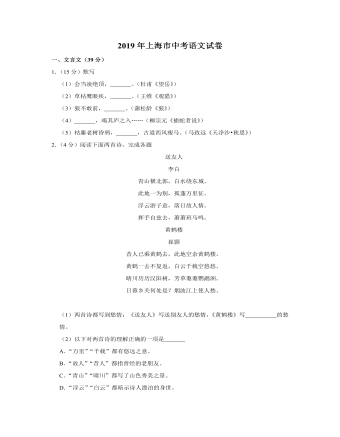
2019年上海中考语文试题及答案
刘标标睁了睁眼,又闭上了。妈妈又叫了几遍,还是没用,只能给睡梦中的儿子穿上衣服。刘标标忽然感觉身上很痒,终于忍不住彻底睁开了眼,大声说:“我不想起床!”“不想起也得起!”妈妈明显在嗓门上占据优势。
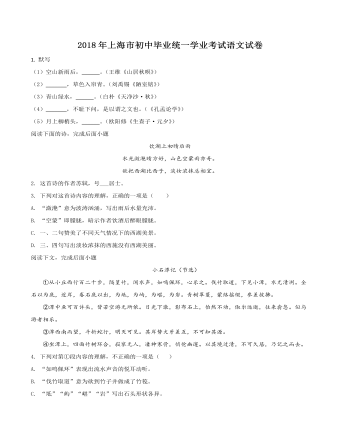
2018年上海中考语文试题及答案
金华的亲戚送了我家一麻袋的橙子。橙甜,汁液淌嘴角。吃了橙,手也舍不得马上洗,用舌头舔一遍,把橙汁舔干净。村里没有人种橙。父亲说,这个橙好吃,下次来你带两棵橙苗来。
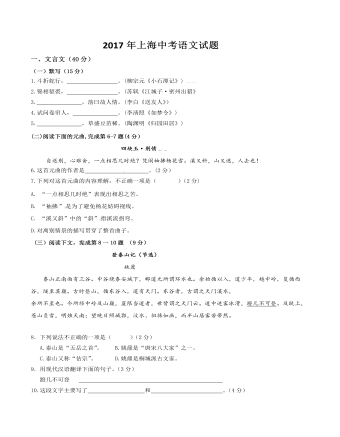
2017年上海中考语文试题及答案
刘伟发了一个月脾气。母亲心疼儿子,就买了一辆旧单车,在一个夏曰的午后推回了家。刘伟骑上单车就跑,天天呼朋唤友,在集镇上闲逛。只有在外面没处混的时候,他才会回家,迎接他的自然是父亲铜铃般的眼珠子。刘伟把他爹当空气,吃完饭,跨上单车又风一样飘走了。
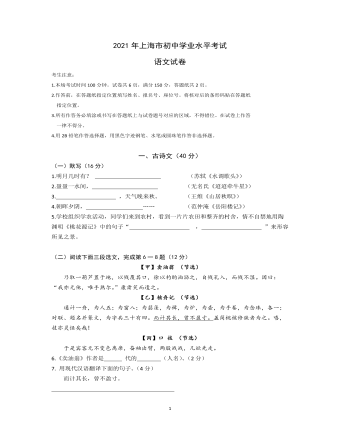
2021年上海中考语文试题及答案
年轻时,朱伯是研究所里做什么都要精益求精的工程师。 后来,他开了间“玩具诊所”,专门修补上了年头的玩具:毛绒娃娃、火车侠、奥特曼……成为玩具修复师以来,朱伯早上8点起床,有时忙到晚上12点,至今已修复了数千个玩具。他喜欢叫玩具患者为“小朋友”,每个“小朋友”都有一个故事。
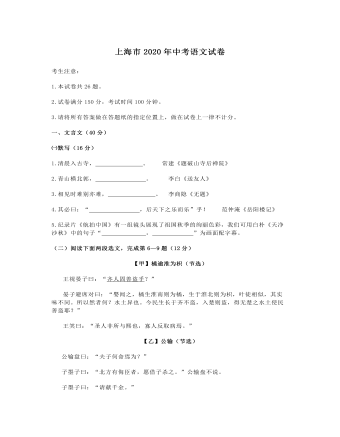
2020年上海中考语文试题及答案
支教的最后一天,为了给我送行,孩子们早早来到学校画黑板画、贴气球、布置教室。他们的欢笑声像高原洁净的空气一般清新怡人,节目是孩子们提前好几天排练的,每表演完一个,我都拼命鼓掌。
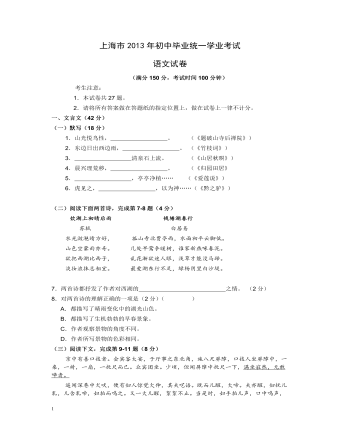
2013年上海中考语文试题及答案
老妈每天都要问我一个问题:“百合有电话吗?”百合是我女儿,在北京念大二。老妈耳朵背,我附耳回答:“有电话。”过不了多久,老妈又问:“百合有电话吗?”
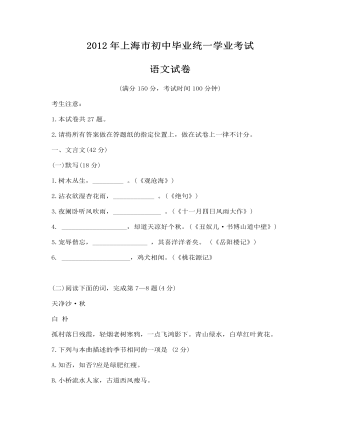
2012年上海中考语文试卷及答案
要审视自己。我们往往容易看到别人的缺点,却不容易看到自己的不足。“为什么看见你弟兄眼中的刺,却不想自己眼中有梁木呢?”说的就是这个道理。如果我们面对别人的过错,能够严格审视自己,就可以更加理性地看待问题。
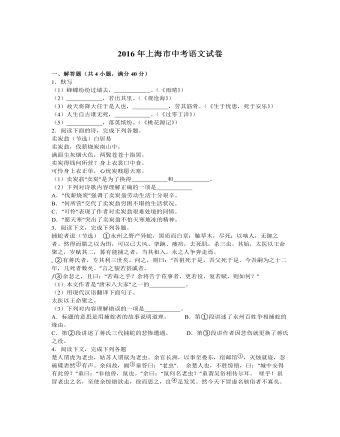
2016年上海中考语文试题及答案
乐乐:欢欢,我发现这里的马路名是我国的某些省份名或城市名,比如南京路、北京路、西藏路、福建路,还有以我的故乡四川命名的呢!欢欢:(2)乐乐:我还想请教你,你的学校在静安区,这名字有来由吗?
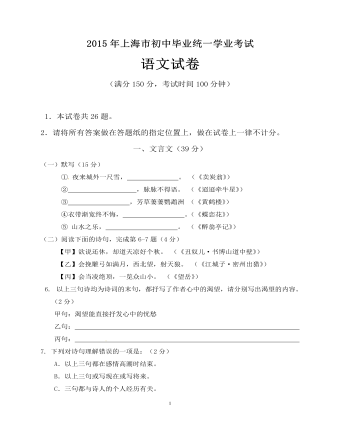
2015年上海中考语文试题及答案
那年我上小学三年级。寒假前到学校拿学期成绩单。回家时我和六七个没带书包的好友同行。刚领的成绩单拿在手上,已经被我们折得皱巴巴了。
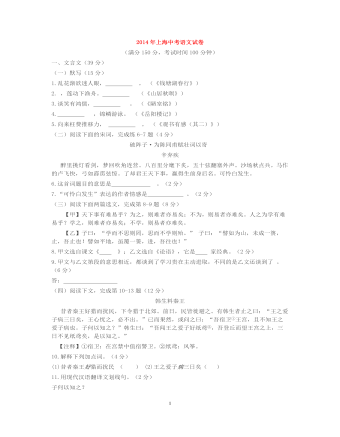
2014年上海中考语文试题及答案
爱因斯坦与上海有特殊的情缘,他曾在1922年两次到访上海,前一次他踏上堤岸就获悉自己得到诺贝尔物理奖的消息;后一次他在福州路工部局礼堂演讲“相对论”,这两次抵沪,他都入住在理查饭店,即今天外滩的浦江饭店。

2009年上海中考语文试题及答案
他告诉我,他是一名高中生,但对学习没有一点兴趣,他的爱好是摄影。他每天都沉迷于摄影当中,学习成绩非常差。父母对他的“不务正业”极为不满,经常指责他。就在两个月前,他最心爱的老相机被愤怒的父亲摔碎了,他一气之下离家出走,和一群网上认识的志愿者来到了这里——梦想了好久的目的地。
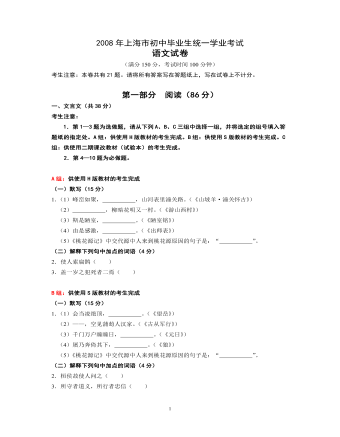
2008年上海中考语文试题及答案
小镇只有一所大学,不大,但哪个国家的学生都有。中国来的一共五名,巧了,全是女生,名付其实五朵金花。珍妮是她们的头儿。五朵金花同吃住同进出,像一家子出来的。其实本来就是一家子。
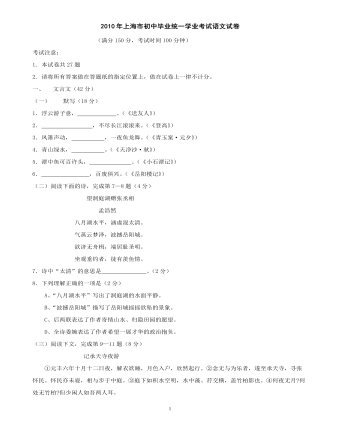
2010年上海中考语文试题及答案
那一年,我即将大学毕业,为了找个单位,天天出去“扫街”,但仍一无所获。我学的是建筑设计专业,找了几家建筑设计院,人家要的不是博士就是硕士。一负责人看着我的简历说,你读书时,还获过不少奖,不错!可是,我们这里暂时不缺建筑设计方面的人才,要不你先来我们这里干个保安什么的吧!等有机会再安排你。
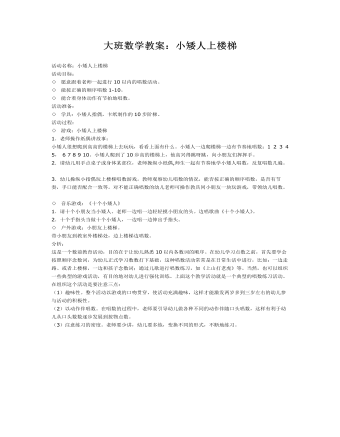
大班数学教案:小矮人上楼梯
活动目标: ◇ 愿意跟着老师一起进行10以内的唱数活动。 ◇ 能按正确的顺序唱数1-10。 ◇ 能合着身体动作有节拍地唱数。 活动准备: ◇ 学具:小矮人指偶,卡纸制作的10步阶梯。 活动过程: ◇ 游戏:小矮人上楼梯 1.老师操作纸偶讲故事: 小矮人很想爬到高高的楼梯上去玩玩,看看上面有什么。小矮人一边爬楼梯一边有节奏地唱数:1 2 3 4 5, 6 7 8 9 10。小矮人爬到了10步高的楼梯上,他高兴得跳呀跳,向小朋友们挥挥手。
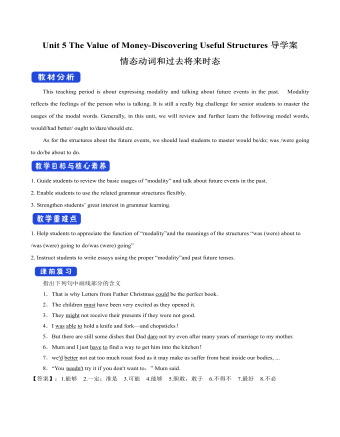
新人教版高中英语必修3Unit 5 The Value of Money-Discovering Useful Structures导学案
4.They were going to find someone to take part in their bet when they saw Henry walking on the street outside.[归纳]1.过去将来时的基本构成和用法过去将来时由“would+动词原形”构成,主要表示从过去某一时间来看将要发生的动作(尤其用于宾语从句中),还可以表示过去的动作习惯或倾向。Jeff knew he would be tired the next day.He promised that he would not open the letter until 2 o'clock.She said that she wouldn't do that again.2.表示过去将来时的其他表达法(1)was/were going to+动词原形:该结构有两个主要用法,一是表示过去的打算,二是表示在过去看来有迹象表明将要发生某事。I thought it was going to rain.(2)was/were to+动词原形:主要表示过去按计划或安排要做的事情。She said she was to get married next month.(3)was/were about to+动词原形:表示在过去看来即将要发生的动作,由于本身已含有“即将”的意味,所以不再与表示具体的将来时间状语连用。I was about to go to bed when the phone rang.(4)was/were+现在分词:表示在过去看来即将发生的动作,通常可用于该结构中的动词是come,go,leave,arrive,begin,start,stop,close,open,die,join,borrow,buy等瞬间动词。Jack said he was leaving tomorrow.
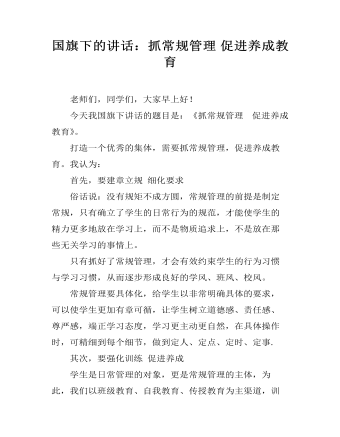
国旗下的讲话:抓常规管理 促进养成教育
老师们,同学们,大家早上好!今天我国旗下讲话的题目是:《抓常规管理 促进养成教育》。打造一个优秀的集体,需要抓常规管理,促进养成教育。我认为:首先,要建章立规 细化要求俗话说:没有规矩不成方圆,常规管理的前提是制定常规,只有确立了学生的日常行为的规范,才能使学生的精力更多地放在学习上,而不是物质追求上,不是放在那些无关学习的事情上。只有抓好了常规管理,才会有效约束学生的行为习惯与学习习惯,从而逐步形成良好的学风、班风、校风。常规管理要具体化,给学生以非常明确具体的要求,可以使学生更加有章可循,让学生树立道德感、责任感、尊严感,端正学习态度,学习更主动更自然,在具体操作时,可精细到每个细节,做到定人、定点、定时、定事.其次,要强化训练 促进养成学生是日常管理的对象,更是常规管理的主体,为此,我们以班级教育、自我教育、传授教育为主渠道,训练学生自我约束,自我管理的能力,让学生在自我教育、自我管理中达到自我完善。